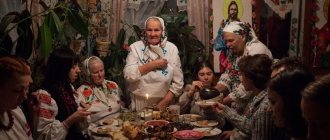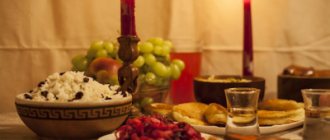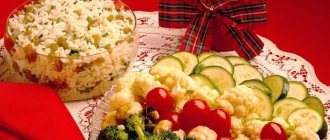The death of a loved one is a great grief. But, unfortunately, it cannot be avoided. If a dear person dies, then loved ones have many questions. Where to bury? How to properly think through a funeral dinner and menu? Is a canteen or cafe better suited for such an event? And this is not a complete list of questions. Today we will talk specifically about the funeral.
Such a meal is not just a meal, but a ritual during which loved ones remember the deceased and his good deeds. During this event, people read a prayer addressed to God. They ask to forgive the deceased all his sins. Of course, the funeral dinner must be properly thought out, the menu of which must be compiled correctly. To make it easier for you to decide on the list of dishes, we will tell you what you need to prepare for this event and why.
Principles of a funeral dinner
Lunch itself should be simple. Its main goal is to maintain the physical and mental strength of those who came to remember the deceased. Everything must be prepared from fresh ingredients. This is how a funeral dinner should be. Its menu can be varied. It all depends on the traditions of the family, wealth, as well as the preferences of the people who come to remember. Although, of course, guests are not traditionally invited, they come themselves.
A funeral dinner is not a feast during which those who come need to be fed to their fullest. The purpose of the funeral is to satisfy the guests, thank them for their participation, remember the deceased, and pray for his soul. Here, as you understand, the main thing is not food, but people - dead and living, who were united by the grief of parting.
When is the funeral held?
The largest funeral dinner is organized on the day of the funeral. Usually everyone who attended the burial ceremony is invited to it. Then, according to tradition, the deceased is remembered on the 9th and 40th days. Close friends and family members come to nineteens and forties. Every year on the day of death, the relatives of the deceased organize feasts in his honor. Anniversary dinners are usually held with family.
Certain days for commemorating the deceased in Orthodoxy were not chosen by chance. It is believed that after death, the soul goes through several stages before its fate is finally decided. Until the ninth day, she explores the expanses of paradise, after which the angels inform the Lord about all the sins and righteous deeds of the deceased. This day is considered a transitional day, in order to support the deceased, services are held, and loved ones read prayers for his soul. The appointment of a memorial meal for this day occurs for the same purpose.
Then, until the fortieth day, the spirit goes to Hell and observes the eternal torment of sinners. The period of the soul's stay in the Underworld is the most difficult. On the 40th day, the fate of the deceased is decided: he either finds eternal bliss or is sent to serve a sentence for his sins. It is believed that the spirit of the deceased gains final immortality a year after death.
Among some peoples living in our country, you can still find an ancient custom. At a wake, one person is chosen from among those present to represent the deceased. He sits at the head of the table, and the other guests surround him with all sorts of honors, asking about how he lives in the other world. After the wake, he is escorted to the cemetery, provided with gifts and invited to return for the next funeral meal.
Planning a funeral dinner
We will describe the menu a little later, now we will look at the main dishes that should be at this lunch. Firstly, this is kutya (the second option is kolivo). What it is? This is a sweet porridge cooked from grains (rice, barley and others), sweetened with honey and raisins. This dish is consecrated at a memorial service. Grain here is a symbol of the resurrection of the soul, and honey and raisins denote spiritual sweetness.
Second prayer
God of spirits and all flesh, having trampled down death and abolished the devil, and given life to Thy world!
Himself, Lord, give rest to the souls of your departed servants: your most holy patriarchs, your eminence metropolitans, archbishops and bishops, who served you in the priestly, ecclesiastical and monastic ranks; the creators of this holy temple, the Orthodox forefathers, fathers, brothers and sisters, lying here and everywhere; leaders and warriors who laid down their lives for the faith and fatherland, the faithful, who were killed in internecine warfare, drowned, burned, frozen to death, torn to pieces by beasts, suddenly died without repentance and did not have time to reconcile with the Church and with their enemies; in the frenzy of the mind of those who committed suicide, those for whom we were commanded and asked to pray, for whom there is no one to pray, and the faithful, Christian burial deprived of (the name of the rivers) in a bright place, in a green place, in a place of peace, from where sickness, sadness and sighing can escape .
Every sin committed by them in word or deed or thought, as a good Lover of mankind, God forgives, as if there is no man who will live and not sin. For You are the only one besides sin, Your righteousness is righteousness forever, and Your word is truth.
What do you need?
The list of products is small:
- 0.5 kilograms of rice;
- 200 grams of dried apricots;
- three tbsp. l. honey;
- nuts (optional);
- 200 grams of raisins;
- 1 liters of water (for soaking).
How is the dish prepared? Soak the grains in water overnight or for several hours. This is necessary so that the porridge turns out crumbly. You need to cook until done. Towards the end, add honey diluted with water, as well as raisins and dried apricots. This is how kutya turns out.
Troparion (from the Sequence of the Dirge)
Build with the depth of wisdom all things humanely and bestow upon all that are useful, O One Creator, rest, O Lord, the soul of Thy servant (or: the soul of Thy servant; for many: the souls of Thy servant), for place their trust in Thee (or for many: place their trust), the Creator and the Creator and our God. Glory, even now: To you and the Wall and the Refuge of the Imams, and the Prayer Book favorable to God, Whom You gave birth to, O Blessed Mother of God, the salvation of the faithful.
Read us conveniently on social networks:
Tags: menu for the anniversary of death, memorial dinner for the anniversary of death, memorial table for the anniversary of death, what to cook for the funeral 1 year
Preparing borscht for a funeral dinner
For this dish, first prepare a broth from meat on the bone (cook for two hours). Then you need to add chopped potatoes. Then take a frying pan, pour oil into it, place it on the stove, pour in the finely chopped onion. After about three minutes, add carrots and beets (also chopped, of course) to the pan. If you treat beets this way, they will be able to retain their color.
The carrots will take on a bright, orange hue. Vegetables need to be simmered in a frying pan until they become soft. Remember that carrots, onions and beets retain their flavor and most vitamins when cooked over high heat. Then pour the contents of the frying pan into the broth, boil everything a little, add shredded cabbage, bay leaves, a few black peppercorns, chopped tomatoes and sweet peppers.
Cook for another 15 minutes. Then you need to taste the dish and add salt. After which you can turn off the heat and remove the borscht from the stove. The dish should be served hot, with sour cream. You can sprinkle with herbs.
First prayer for the departed
Remember, O Lord our God, in faith and hope the life of Thy eternal departed servant (Thy departed servant, Thy departed servant) (name), and as the Good and Lover of mankind, forgiving sins, and consuming untruths, weaken, forsake, and forgive all who will. (her) sins and involuntary, elevating him (s) to Your holy second coming into the communion of Your eternal blessings, for the sake of the only faith in You, the true God and Lover of mankind; for Thou art the resurrection and the life and the rest of Thy servant (name), Christ our God, and to Thee we ascribe glory, with Thy beginningless Father, and with the Most Holy Spirit, now and ever and unto ages of ages, Amen.
Preparing sweets for the funeral
Take the prepared puff pastry. Let it thaw, then roll it out. Then take a knife and draw rectangles with it. Place banana filling on them (fruit cut into small pieces). Then bring the edges of the dough together so that the filling is completely enclosed. Next, pin the products a little. Bake in an oven preheated to 220 degrees for about fifteen minutes. The products should be browned. Sprinkle the finished puff pastries with powdered sugar.
The first menu option for thirty people
Now let's talk about what a funeral dinner should be like. The menu after the funeral may vary. We offer ours:
- Kutya (one liter pan for two). The food is eaten immediately after the prayer is read. Everyone present at the wake is required to take three spoons of koliv;
- borscht (one five-liter pan);
- 30 fried thighs;
- Fish in batter (two carcasses will be enough);
- three pieces of herring (cut into slices);
- mashed potatoes (one pan);
- sliced sausage and cheese (700 grams of each product);
- cutlets (30 pieces, approximately 3 kg of minced meat);
- salad of fresh cucumbers and tomatoes or vinaigrette (two kilograms);
- pickled cucumbers and tomatoes (one and a half kilograms);
- sweet buns (two pieces for each invitee);
- sweets (two types for each guest, approximately 1.5 kg);
- five bottles of mineral water;
- three bottles of vodka and the same amount of Cahors.
If you are hosting a memorial dinner for the year, this menu would be perfect for the event. Kutya, however, can be removed from the list. It is a mandatory dish only at wakes after funerals. And then - as you wish.
Why do funerals take place and how important are they?
The tradition of holding a posthumous meal has come to us from time immemorial. The pagan tribes that inhabited the territory of the modern Russian state held funerals on a large scale. If one of the elders died, everything that could be useful in the afterlife was placed in his grave. Often all kinds of food were brought to the burial site.
During the time of the first Russian princes, funeral traditions changed. The deceased were now buried under mounds, and a magnificent feast was held in their honor - a funeral feast. It is believed that these meals became the prototype of modern funerals.
With the passage of time and the change of eras, the tradition of the funeral meal has undergone numerous changes. New rules and rituals appeared.
Calling a ritual agent
city funeral service
Cemeteries of St. Petersburg
detailed information
Funeral arrangements
in St. Petersburg and the region
An important role was given to dishes in the funeral menu. Of particular importance was their composition, the sequence of presentation and observance of the ceremony. Echoes of existing traditions can still be found today. The rules according to which the funeral table is set have existed for centuries.
The wake is an important part of the funeral. While guests share memories of moments in their lives associated with the deceased, his image seems to be in the air. However, a memorial meal is held not only to honor the memory of the deceased. The support of relatives and friends helps the family of the deceased to quickly accept their grief and alleviate mental anguish.
Second menu option for 12 people
Now let’s look at a sample menu for a funeral lunch in a cafe or at home (for forty days). So, the list of products:
- fish fried in batter (two kilograms);
- mashed potatoes (2.5-3 kilograms);
- Olivier salad (two kilograms);
- cutlets (12 pieces, approximately 1.2 kg of minced meat);
- sandwiches with red fish or sprats;
- pies with cabbage or potatoes (12-15 pieces);
- pickled cucumbers and tomatoes (about 1 kg);
- 5 liters of liquid (water + juices + compote)
- candies and sweet pies (optional).
If you plan to hold another memorial dinner later, the menu for six months, for example, could be the same. Although, of course, you can adjust the list of dishes at your discretion.
Conducting funerals during Lent
Dishes for the funeral table during Lent are prepared accordingly. If the fast is not strict, then meat dishes are replaced with fish. When meals occur during Lent, preference should be given to plant foods. But this is no reason to think that the funeral meal will be meager. There are many dishes that will pass even the most stringent selection.
For starters, light mushroom soups or lean cabbage soup are served. Without animal products, you can prepare most traditional snacks: pancakes, pies with cabbage, baked goods with rhubarb, dried apricots and other dried fruits, potato dishes and much more.
Not everyone present at the funeral will strictly adhere to the restrictions. However, the presence of Lenten dishes is necessary in case one of the guests remains true to his beliefs.
Recently, wakes are increasingly being held outside the home. Organizing a funeral is not an easy job, and not everyone has the moral and physical strength to set a sumptuous table. In addition, if a large number of guests are expected at the funeral, a spacious room will be required for the funeral meal.
Today it is possible to organize a wake in many restaurants and banquet halls, but holding a meal and solving all organizational issues takes a lot of time and effort. To ensure that the funeral goes smoothly, you can turn to professionals for help. The City Ritual Service in St. Petersburg will help organize a worthy memorial meal for any number of guests in the shortest possible time.
Lean
As you think through everything, pay attention to whether the commemoration falls during the post. If the answer is yes, then the funeral dinner (menu) needs to be adjusted. A Lenten set of dishes will not only be appropriate. but even necessary. What to prepare for such a funeral? How to adjust the usual menu, making it lean? Now let's make an approximate list of foods:
- uzvar;
- lean borscht;
- Kutya;
- lean pancakes;
- Lenten pies;
- potatoes with mushrooms;
- cabbage or carrot cutlets;
- vegetable salad (cabbage, tomatoes, cucumbers);
- the vinaigrette.
Traditional dishes for funerals
Funerals are an ancient tradition. It lies in the fact that the people helping with the burial must be fed. That is, the point is not in the feast, but in the food. People who are not familiar with the traditions try to make a real feast out of the wake. They prepare pickles and strive to make the menu varied and “expensive.” It is not right.
The point is to feed people simply and nutritiously. The wake is a dinner. It should consist of three courses. Something like this:
- first (usually borscht);
- second course;
- compote with a bun or pie.
No excesses in the form of cuts and snacks should be placed on the table. Firstly, people are not supposed to linger at the feast. Secondly, this is not a holiday. Extra “gatherings” are disrespectful to the memory of the deceased.
Alcohol
We described in detail how to properly think through a funeral dinner, we also discussed its menu. Now let's touch on another important topic. “Which one?” - you ask. Should you drink alcohol during a funeral? There is no clear answer to this question. Some priests believe that during the funeral dinner it is possible to drink a little red wine. The Church condemns the consumption of alcoholic beverages during such a ceremony. Therefore, here you must decide for yourself whether you need alcohol at the funeral dinner or not.
Dough products
It is customary to end the meal with dessert. You can also cook a wide variety of dishes here. Funeral pancakes are considered obligatory. If potatoes, mushrooms and cabbage are already on the table, sweet pies made from lean yeast dough filled with apples and berries, dried apricots, and dried fruits will diversify the menu. They will be complemented by gingerbread cookies and any sweets. The choice of drinks served at a wake is berry compotes and jelly, regular or apple kvass, drinks with honey and lemon, and tea.
The hosts are advised to prepare more pastries and desserts, since at the end of dinner they are usually distributed to guests on the road so that they can remember the deceased at home with all those who were unable to attend the funeral. According to Orthodox canons, the meal should be concluded with an expression of support and sympathy for the relatives of the deceased and wishes for their well-being.
Every person in life is faced with the loss of a loved one who needs to be remembered and honored throughout his life. The menu for a funeral must, first of all, comply with the religious norms of the deceased. In addition, each dish must be prepared with high quality, so choosing a good establishment is a responsible step.
Our complex offers its own organization of such an important event. We offer menus for 40 days of funerals and other important dates. Our variety of offerings will suit any budget. For example, you can choose a menu for 700 rubles per person if your budget is small.











